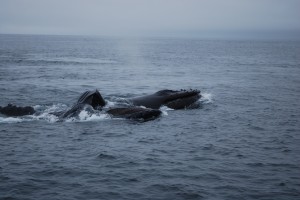
Lunge feeding humpbacks filling their three stomachs
If you spend a lot of time wondering where exactly each organ is located in a marine mammal, then the article on anatomical dissection in the Encyclopedia of Marine Mammals is for you! Authors John Reynolds and Sentiel Rommel painstakingly detail every organ location, anatomical nuance and unusual characteristic known to man by describing and comparing the anatomy of a California sea lion, Florida manatee, harbor seal and common bottlenose dolphin.
One take away message is that as mammals we are united in our physical similarities despite our chosen land vs. water habitat. Yes of course there are differences, but reading through the article I had flashbacks to biology 101 in high school. We have all the same parts; it’s just that the layout or exact structure may be different depending on an animal’s diet or lifestyle.
Instead of relaying every insane detail, I’ve decided to highlight a few interesting facts that I came across reading this article. Apparently, cetaceans (whales, dolphins and porpoises) have two or three stomachs, usually three. These three stomachs provide the same services as the standard one stomach. The first and third stomachs act as an entrance and exit respectively. While the second stomach does all the work of a typical stomach, breaking down the food, etc.
Another interesting fact is that sirenians (manatees and dugongs) “have the most remarkably developed gastrointestinal tract.” Ooh la la. They are “herbivores and hindergut digesters (similar to horses and elephants) so the large intestines is extremely enlarged, enabling it to act as a fermentation vat.” This is awesome, it’s like the sirenians are making their own wine.
And the last crazy fun fact is that many marine mammals have specialized reniculate kidneys, which means multilobed kidneys. Each lobe has all the same parts and functions as a fully fledged kidney. It’s like having several mini-kidneys within one large kidney. Large land animals also have this unique trait leading to the theory that reniculate kidneys are associated with large body size.
For humans the next evolutionary step should be reniculate bladders. Hold it longer without pain!
Fascinating stuff! I can think of several occasions where an extra bladder would have been useful.
What is a dugong? I’ve never heard of it.